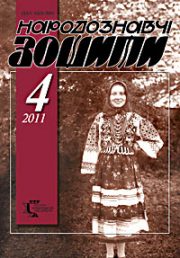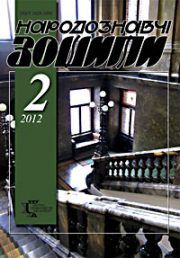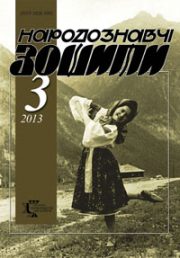The Ethnology Notebooks. 2019, № 3 (147), 535—547
UDK 94(477)”15/16″(092)
DOI https://doi.org/10.15407/nz2019.03.535
THE TOMB OF HETMAN IVAN MAZEPA: HISTORY, RESEARCH, LEGENDS AND RETELLINGS
SEGEDA Sergij
ORCID ID: http://orcid.org/0000-0001-6772-8387
Doctor of Sciences in History, Lead Researcher
of the Institute of Ethnology of the National Academy
of Sciences of Ukraine,
in the Department of Historical Ethnology,
15, Svobody Avenue, 79000, Lviv, Ukraine
Contacts: е-mail: sergij_segeda@ukr.net
Abstract. Ivan Mazepa is one of the most prominent historians of Europe at the end of the seventeenth and early eighteenth centuries, whose image has more than once attracted the attention of domestic and foreign researchers and artists. There is more than two thouthand bibliography of scientific works and art papers devoted to this bright personality. There were many myths and distortions created during the life of Ivan Mazepa, the number of which greatly increased after his death. Many of them relate to the last period of his political activity, the completion of the earthly path, the location of the grave and the fate of the corpse.
The question of where and in what circumstances Ivan Mazepa was buried was first put up in the national historical literature in the second half of the nineteenth century. Later it confused the scholars of the Ukrainian political emigration of the twentieth century and has not lost its relevance up to now. The unresolvedness determines the purpose of this publication — to summarize the results of previous researches by involving a wide range of historical evidence and legends.
The object of the article is a collection of sources relating to the grave of Ivan Mazepa, the subject is the main versions of the fate of his mortal remains. In the process of scientific research, the principle of historicism in combination with elements of structural-functional analysis and methods of ethnological science was used. In preparing the article, used the own observations of the author who participated in expeditionary surveys of the places of the first burial and reburial of Ivan Mazepa were used.
On the basis of the analysis, the chronology of events related to this issue is traced. The main, often overly contradictory, versions of the fate of the hetman Ivan Mazepa are given. The author comes to the conclusion about the urgent need for archeological excavations on the territory of the destroyed monastery of St. Yuriy (George) in Galati (Romania) and the installation of a memorial sign in place of the last rest of this outstanding figure in Ukrainian history.
Keywords: history, Hetman, Ivan Mazepa, tomb, grave, monastery, legends, retellings.
Received 22.03.2019
REFERENCES
Kovalevskaya, A.A., & Udod, O.A. (Eds.). (2009). Mazepiana: materialy do bibliohrafii (1688—2009). Kyiv: Tempora [in Ukrainian].
Antonovich, V. (1885). Moldavian information about the burial place and the grave of Mazepa. In Kyiv Starina (Vol. VІІ, pp. 501—505). Kyiv [in Russian].
Galin, M. (1930, 4 may). The Tomb of Het’man Mazepa. Tryzub, 18 (226), 14—15 [in Ukrainian].
Trepke, V. (1932, 18 september). Traces and monuments of Hetman Ivan Mazepa in Romania. Tryzub, 36 (344), 3—10 [in Ukrainian].
Sichynsky, V. (1953, october). Death and Tomb of Hetman Mazepa. In Visnyk. Orhan oborony chotyr’okh svobid Ukrainy (Year VII, part 6 (60), pp. 15—18) [in Ukrainian].
Rychka, V. (1996). Ivan Mazepa in the cities of eternity (historical detective). Istoriia Ukrainy, 12, 1—3; 13, 7—8 [in Ukrainian].
Rychka, V. (2008). The last mystery of Ivan Mazepa. In Baturyn old days. Collection of scientific works devoted to the 300th anniversary of the Baturin tragedy (pp. 329—337). Kyiv: Vydavnytstvo imeni Oleny Telihy [in Ukrainian].
Rendiuk, T. (2010). Hetman Ivan Mazepa — well-known and not known … Kyiv: Publishing House Adef-Ukraine [in Ukrainian].
Rendiuk, T. (2011). Ukrainian emigration in Romania. In Scientific notes of Ternopil National Pedagogical University named after Volodymyr Hnatyuk. Series: History (Vol. 2, pp. 155—163). Ternopil: View of TNPU them. V. Hnatyuk [in Ukrainian].
Segeda, S. (2010). Hetmanski tombs. Kiev: Our time [in Ukrainian].
Lagus, V. (1852). Karl XII in Southern Russia. In Notes of the Odessa Society of History and Antiquities (Vol. 3, pp. 306—337). Odessa [in Russian].
Sapozhnikov, I., Levchuk, V., Sava, E. (Ed.), & Plosnita, E. (Ed.). (2017). Studies and descriptions of the site of the camp of Charles XII in Varnitsa in the 1810—1850. In Historic site «Camp of king Charles XII of Sweden at Varnita». Recovery of the memory (pp. 41—56). Chisinau: The National History Museum of Moldova [in Russian].
Krupnitsky, B. (2011). Around Kalablike in the beginning of 1713. In Kovalevskaya O. Collection «Mazepa»: reconstruction of the publishing project from 1939 to 1949 (pp. 59—62). Kyiv: Tempora [in Ukrainian].
Semenko, O. (1977). Kharkiv, Kharkiv … Contemporary [in Ukrainian].
Borshchak, I., & Martel, R. (1991). Ivan Mazepa: life and impulses of the great hetman. Kyiv: Svens [in Ukrainian].
Yensen, A. (1992). Mazepa. Historical paintings. Kyiv: Soviet writer [in Ukrainian].
«The humble memorial of the Zaporizhzhya troops to the holy kingdom of Sweden» of October 7 (September 26, in the old style), 1709. (2001). In Kresin O. V Political and legal heritage of the Ukrainian political emigration of the first half of the XVIII century (pp. 329—333). Kyiv: State and Law Institute named after VM Koretsky of the National Academy of Sciences of Ukraine [in Ukrainian].
Astvatsaturov, G. (1997). Benderskaya fortress. Bendery: Scientific Society of Bulgarians of the Republic of Moldova [in Russian].
Interrogation of Gregory Gertsika about his participation in the betrayal of Mazepa. (1883). In Kiev Starina (Vol. V, pp. 595—610). Kiev [in Russian].
Asaki, G. (1988). Historical short stories. Diary of a Moldavian traveler. Featured articles. Chisinau: Literatura artistike [in Russian].
Orlik, P. (2006). Constitution, Manifestos and Literary Legacy: Selected Works. Kyiv: MAUP [in Ukrainian].
Titov, A.A. (1893). Notes of an engineering officer Martos about the Turkish war in the reign of Alexander Pavlovich (1806—1812). In Russian archive, 7 (Year XXXI, pp. 305—368). Moscow [in Russian].
Ivan Mazepa (1992). Kyiv: Veselka [in Ukrainian].
Trepke, V. (1933). Pilgrimage to the grave of Hetman Mazepa. In Historical calendar of almanac of Red Kalina in 1933 (pp. 21—26). Lviv [in Ukrainian].
Zaremba, S. (1997). The share of Mazepa’s grave. In New research on the monuments of the Cossack era in Ukraine (pp. 4—8). Kyiv [in Ukrainian].
Sadovsky, M. (1917). Reminiscences from the Russo-Turkish War of 1877—1878. Kyiv: Printing company «Time» Retrieved from: http://library.kr.ua/elib/sadovskiy/spomyny.html (Last accessed: 10.12.2018) [in Ukrainian].
Lazarevsky, M. (1973). Svetlotiny (Collection of historical essays, stories, articles, memoirs). 1949—1969. Melbourne: The Union of Ukrainian Writers «Word». Australian branch [in Ukrainian].
Litvin, M. (1993, 23 april). The mystery of Hetman Mazepa. In Nash chas, 16 (53), 3 [in Ukrainian].
Kostomarov, N.I. (1992). Mazepa. Moscow: Respublika Publishing House [in Russian].
Poznak-Khomenko, N. (2017, october 18). Viktor Yushchenko initiated the return of the legendary Ivan Mazepa to Ukraine. In Ukraina moloda. Retrieved from: https://risu.org.ua/page.php?_lang=ua&path=monitoring/&name=kaleido_digest&id=68652&alias=& (Last accessed: 19.12.2018) [in Ukrainian].







